Servant leader earns lifetime achievement award
Area agencies, UTMB Health band together to prepare for annual beach party on Bolivar
Page 05
League City Campus now designated as a Level III Primary Stroke Center
Page 07
Strategies & solutions for sleep-deprived shift workers
Pages 10
Responders’ swift actions save rider’s life
Pages 08

Throughout her decades-long career, Chief Lucille Maes with the Angleton Area Emergency Medical Corps (AAEMC) has seen a variety of changes in the industry and the world. One thing, however, has remained constant—her commitment to the communities she serves.

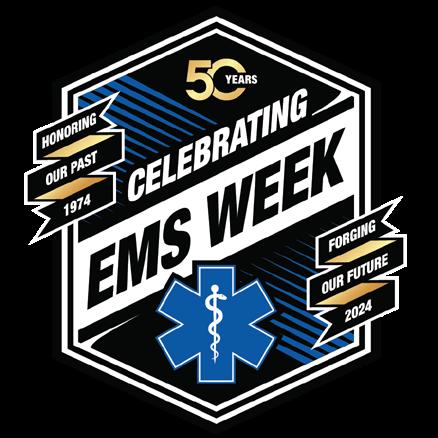
VOL. 2, NO. 3 AN EMERGENCY SERVICES NEWSLETTER CREATED BY SEE MORE INSIDE:
50 Years of EMS Week - Let’s Celebrate! See more on page 07
Deputy Chief Lloyd Ayers and Chief Lucille Maes with AAEMC crew members Jerry Hung and Amanda Gisler.
See more on page 03 PARTNER SPOTLIGHT EMS WEEK Crossword Puzzle Page 02
UTMB Health Cardiologist leads EKG training sessions
It’s not uncommon for medics to conduct electrocardiograms (EKGs) while in the field.
To ensure the EMS personnel in our region are up-todate on the best practices for performing these tests and interpreting their results, UTMB Health Cardiologist Dr. Muhammad Raja has been making the rounds to area agencies sharing his tips and tricks for using this common diagnostic tool.
After a request from the Galveston County Emergency Services District No. 2 team, Dr. Raja led an interactive presentation in February on the topic that covered everything from electrode placement to ventricular rate analysis.
The positive response from that discussion exposed a need and desire to schedule more trainings on the matter, so from 10 a.m. until noon, Thursday, May 23, Raja will conduct another session on the UTMB Health League City Campus.
Individuals interested in participating should RSVP to Richard Arocho, UTMB Health outreach and liaison specialist, via email at riarocho@utmb.edu by May 22.
The event will take place in Room 2.204 in the UTMB Health Medical Plaza One building located at 2240 Gulf Freeway South in League City. A virtual option for the meeting will be available as well.
Participants, both in-person and online, will receive two CEU credits.
“Sharing information and education with our EMS partners is an important part of my job,” said Dr. Raja. “I enjoy these opportunities to get in front of these crews, answer their questions and discuss the best ways to care for the communities we serve.”
For more information, contact Richard Arocho at riarocho@utmb.edu or visit utmbhealth.com/ems.
About THE DISPATCH
The Dispatch is a publication of the University of Texas Medical Branch (UTMB Health) and is produced by UTMB’s Office of Marketing and Communications for our EMS partners. The purpose of this publication is to celebrate the incredible work of the EMS agencies in our communities while sharing news about the services available at UTMB Health.
This newsletter is focused on telling your stories, answering your questions and sharing your successes. Send us your questions, your story ideas, your photos or any EMS-related news you’d like to brag about to ems@utmb.edu
EMS Dispatch Crossword Puzzle
EMS Dispatch Crossword Puzzle
[1] Beach party location [2] EMS team that responded to Surfside accident
[3] First name of nurse and program manager with UTMB Health Trauma Services in Galveston
[5] How many years celebrating EMS week
[8] Last name of UTMB Health Adult and Pediatric Sleep Specialist
Across:
[4] Location for most recent Lecture Series
[6] How many years of service Chief Maes has with AAEMC
[7] Last name of cardiologist leading EKG refresher trainings
of
[9] Designated as Primary Stroke Center
THE DISPATCH
CONTINUING EDUCATION
02 | THE DISPATCH AN EMERGENCY SERVICE NEWSLETTER CREATED BY UTMB HEALTH Solution is on the back page*
1 2 3 4 5 6 7 8 9 Down: Across: 1. Jeep Weekend location 4. Location
most recent Lecture Series 2. EMS team that responded to Surfside 6. How
years
service Chief Maes has accident with AAEMC 3. first
nurse
manager 7.
UTMB
Galveston 9.
5.
8.
for
many
of
name of
and program
Last name
cardiologist leading EKG with
Health Trauma Services in refresher trainings
designated as Primary Stroke Center
how many years celebrating EMS week
Last name of UTMB Health Adult and Pediatric Sleep Specialist
Down:
Servant leader earns lifetime achievement award
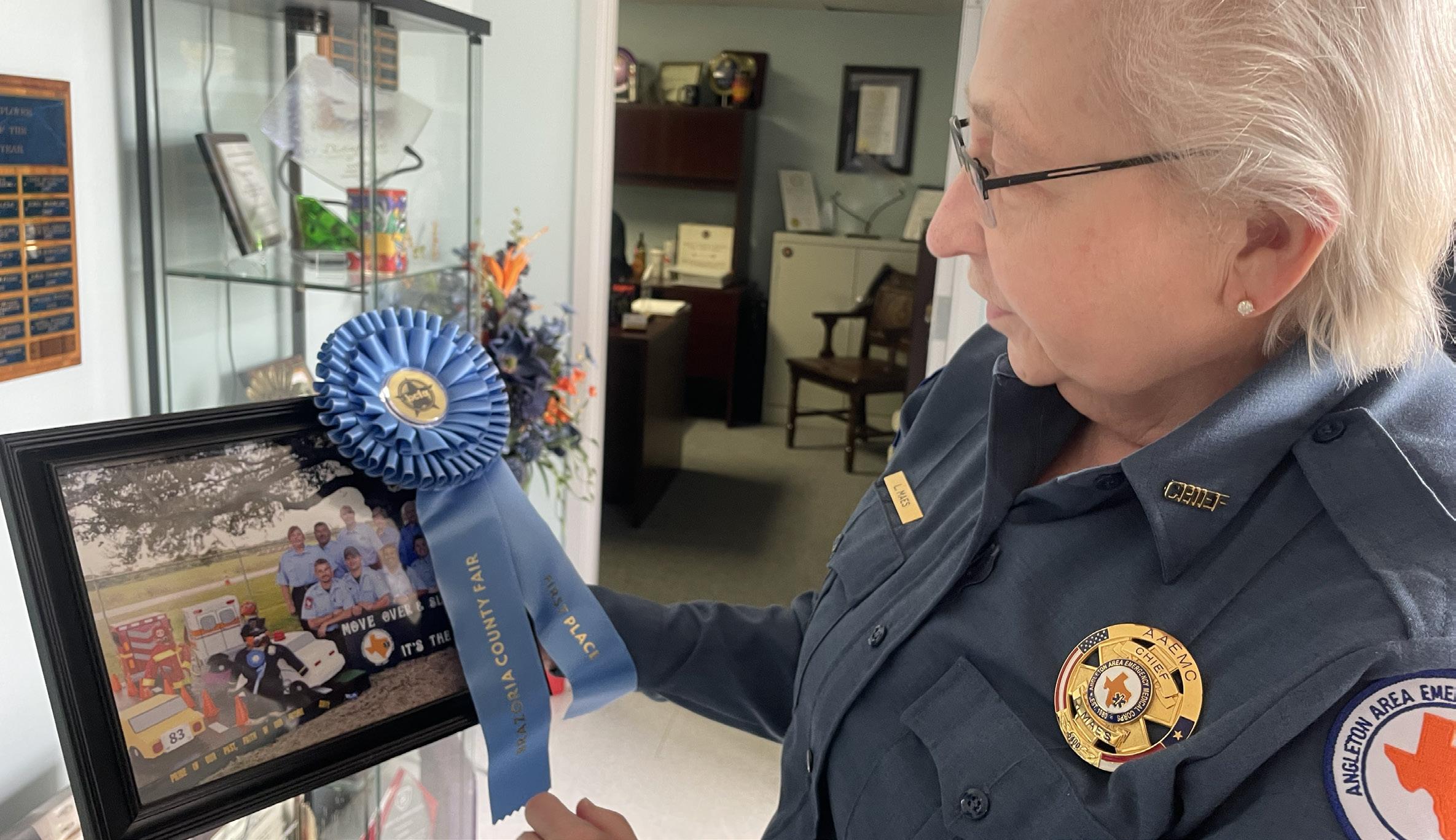
Throughout her decadeslong career, Chief Lucille Maes with the Angleton Area Emergency Medical Corps (AAEMC) has seen a variety of changes in the industry and the world. One thing, however, has remained constant—her commitment to the communities she serves.
After dedicating so much of her life to what she does now, it’s crazy to think that this was a career that almost never began.
In the 1980s, a young Maes was just starting to stretch her wings and find her way in the world. She landed a well-paying job in outside sales in the area, and before 1990 she was making six figures.
On a whim, she joined a friend who was doing training to become an emergency medical technician (EMT).
While the friend inevitably decided that career path wasn’t for her, and thus didn’t finish the training, the experience awakened something in Maes.
“I was instantly hooked,” she said, noting that shortly after the training she left her well-paying job to be a volunteer in the field.
In fact, it was more than a handful of years before she secured a paying gig with the team that got her $32,000 a year and partially covered insurance for her truck.
While it might not seem like a fair trade to some, Maes knew in her heart she wasn’t just making a career change—she was answering a calling.
“This profession definitely chose me,” she explains with a smile.
A volunteer with the organization for several years, it didn’t take long for her to find her place in the leadership realm within AAEMC.
“For me, AAEMC has always been home,” she said. “And as far as I’m concerned, we have the best crew around.”
Fellowship in the field
Currently in her third decade with the organization, Maes has her fair share of stories from the field that range from harrowing to heroic—and everything in between.
“In this job, you have the opportunity to help someone on their worst day and really
PARTNER SPOTLIGHT THE DISPATCH AN EMERGENCY SERVICE NEWSLETTER CREATED BY UTMB HEALTH | 03
make a difference,” she said. “It is not always about the medicine or treatments. Sometimes you can make it better by listening, offering a warm smile or holding a person’s hand. Every call, shift and day are different, so you have to be on your game all the time.”
Maes extends this same attention and care to the nearly 27 paid and 23 volunteer members of AAEMC she has the pleasure of working alongside each day.
She’s quick to call out that many are medics with area agencies too, including Amanda Gisler who in addition to her role with AAEMC works with Friendswood EMS.
“I love working here,” Gisler says. It has such a family feel to it. Chief really has our back.”
Maes also works hard to “have the backs” of other area first responders, including the fire department in the community. “We show up to their calls, and they can send us away if they need to, but we’re there for the firemen and women,” she said.
Additionally throughout her career, Maes has worked hard to maintain a great working relationship with members of the UTMB Health community. Tonya Visor, senior communications specialist with UTMB Health, has served the community alongside Maes for decades and has nothing but positive things to say about her.
“Lucille is just wonderful and is a joy to work with,” said Visor. “She knows we’re all here for the greater good, and she emanates that spirit throughout everything she does.”
Tireless advocacy
For Maes, a teamwork-first process is key for effectively caring for the community. A tireless advocate for the EMS profession as a whole and a firm believer in cultivating camaraderie across agencies and entities,
Maes has been intentional about instilling that mindset in her crews over the years.
Not one to just talk the talk, she’s walked the walk using this collaborative approach her whole career, being deliberate about serving on a variety of advisory and EMS advocacy boards, committees and organizations across the state.
A few of the groups lucky enough to be on the receiving end of Maes’s time, energy and commitment include the Texas Line of Duty Death (LODD) Task Force, the Southeast Texas Regional Trauma Advisory Council, and the Governor’s EMS and Trauma Advisory Council (GETAC).
Her efforts on this front were recognized in late 2023 during the annual Texas EMS conference when she was awarded the Lifetime Achievement Award from GETAC—a well-earned nod to all she’s done in that group during her tenure.
Like the true leader she is, Maes never alludes to any of these accolades, and instead she takes every opportunity to shine
the light back on her colleagues and the wonderful work they’re doing.
“I’m not anything without them [her crew],” she said.
The end of an era
On the heels of receiving the honor from GETAC, Maes, who just celebrated 35 years of service with AAEMC, has announced that she’ll be closing this chapter of her life in June when she retires.
While she’ll continue to support the organization remotely as the new chief Lloyd Ayers, who is currently serving as AAEMC’s Deputy Chief, gets accustomed to his new role, there’s no doubt it’s the end of an era for the region. The official change in leadership will take effect on June 22.
“Ayers will do great in this role,” said Maes. “The community will continue to be well taken care of.”
With a history of working together on and off for nearly two decades, Ayers and Maes have a connection that’s palpable as the
two roam about the grounds of AAEMC’s home base.
As Ayers looks ahead to what’s to come as the new chief, there’s a mix of emotions ranging from excitement and hope to bittersweet reflection.
“I’m looking forward to continuing to grow everything she’s started,” he says.
A resident in the area since his junior high school days, Ayers is passionate about serving the region and doing it well.
“He knows the community and knows what works and what needs to be changed,” says Maes, adding that Ayers has always listened and learned quickly – two qualities that will serve him well in the new role.
Thinking back on all the living she’s squeezed into this season of her life, Maes keeps it concise using one line to capture the full spectrum of emotions that comes with this big milestone and transition.
“It’s been challenging and rewarding, and I wouldn’t change a thing.”
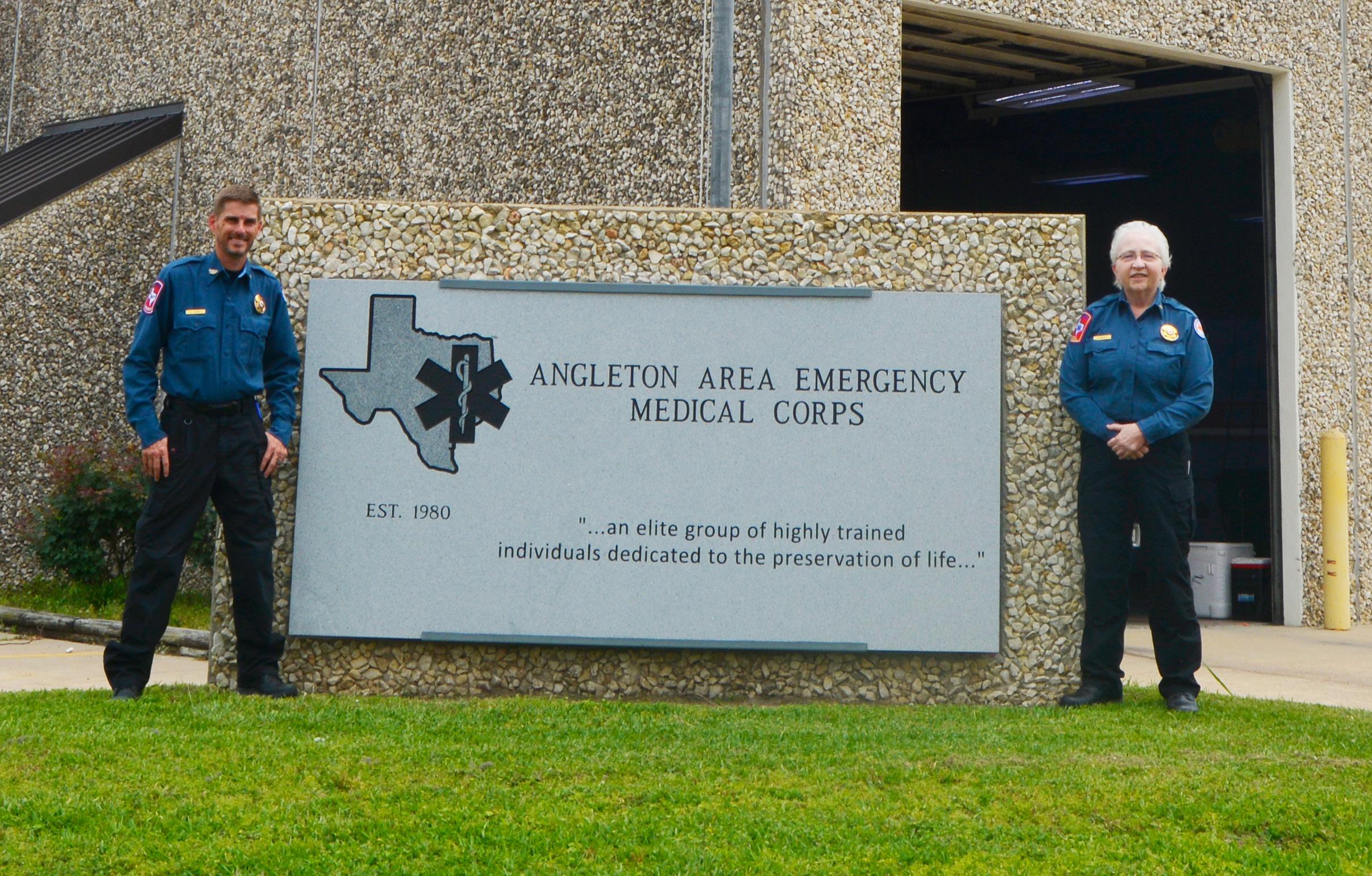
PARTNER SPOTLIGHT 04 | THE DISPATCH AN EMERGENCY SERVICE NEWSLETTER CREATED BY UTMB HEALTH
Deputy Chief Lloyd Ayers with the Angleton Area Emergency Medical Corps will take over for Chief Lucille Maes when she retires in June.
Area agencies, UTMB Health band together to prepare for annual beach party on Bolivar

Every year, tens of thousands of people descend on Crystal Beach on the Bolivar Peninsula for what locals call “Go Topless” weekend.
Originally named for the fact that Jeep enthusiasts use the weekend as the kickoff to the season of driving around town without the tops on their vehicles thanks to the warmer weather, the weekend traditionally takes place in the middle of May. This year’s festivities are planned for the weekend of May 18.
While attendees are drawn to the fun and revelry, for local first responders and medical professionals the celebration is a time filled with numerous calls, emergencies and more.
“It’s one of our busiest weekends,” said Miranda Culligan, nurse and program manager with UTMB Health Trauma Services in Galveston.
She noted that it’s not uncommon for UTMB Health to have more trauma cases that weekend than other busy times like Mardi Gras or Lone Star Rally. That’s why UTMB Health is one of the many
organizations included in the Galveston County Emergency Management Services team’s planning efforts that take place months ahead of the event each year. In addition to UTMB Health, the emergency planning group includes representatives from Galveston County Emergency Services District No. 2, the Sheriff’s Department, Department of Public Safety, Galveston County Constable Precinct 2, Galveston County Parks and Recreation and the National Weather Service.
During their meetings, which kicked off in February of this year and will continue monthly until the event, the teams discuss a variety of topics including the resources needed, response action plans, communications protocols for both radio and media operations, contingency plans for mass casualty incident (MCI) events, response times, traffic and weather impacts and more.
“As we’re planning, we keep certain things top of mind,” said Doug Saunders, district manager with Galveston County Emergency Services District No. 2. “These include first responder safety, maintaining continuity of services to residents during the event, and how we’ll provide care and treatment to those injured with on-hand supplies and equipment.”
Saunders’ first run with the annual event was
in 2019, and it was a memorable one with more than 40,000 participants and 110 EMS calls in a 48-hour period. Luckily, for the event that year he initiated an incident action plan between his team and the volunteer fire departments on the Peninsula. Since then there’s been a unified command between the Sheriff’s Department and the Galveston County Emergency Services District No. 2 that allows the agencies to work together to assist each other and meet their ultimate goal of ensuring public safety.
With each passing year, the emergency planning team learns valuable lessons on how things can be improved in the future.
“Weather and tide can play a huge role in our response capabilities,” he said.
He went on to explain that because of those factors and the difficulty of locating people on a beach that stretches down a peninsula, agencies now have a heavier presence “in the sand” – a development he says came out of the planning meetings.
While the event is a big lift every year, Saunders and Culligan never lose sight of the fact that without teamwork, none of this would be possible.
“It takes all organizations working together to ensure services can be provided for this event,” he said. “It’s truly a team effort.”
LOOKING FORWARD THE DISPATCH AN EMERGENCY SERVICE NEWSLETTER CREATED BY UTMB HEALTH | 05
UTMB Epilepsy Program given highest accreditation by national association

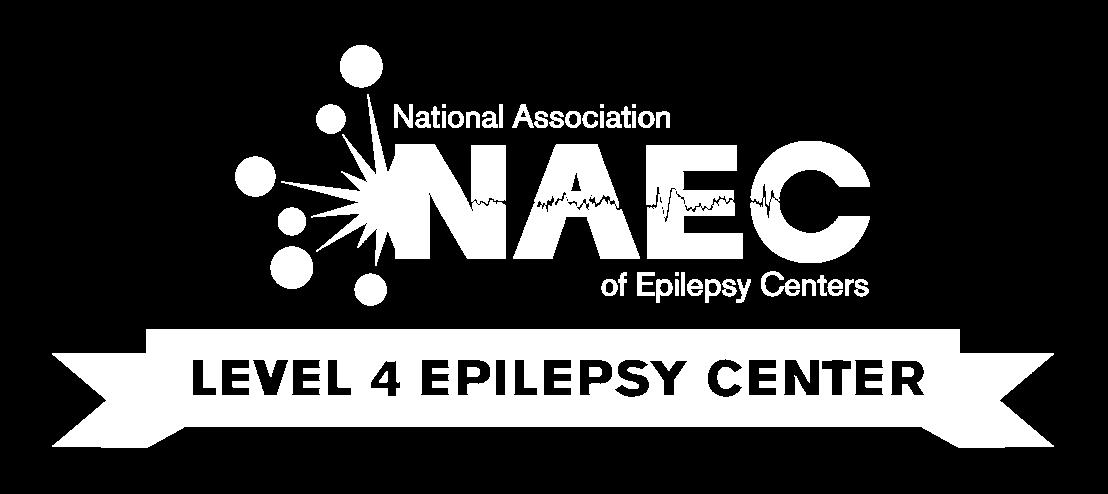
Focused on providing the best possible care for patients with seizures, the University of Texas Medical Branch Epilepsy Program has received accreditation by the National Association of Epilepsy Centers (NAEC) as a Level 4 Epilepsy Center.
The designation is the highest level of accreditation offered by the NAEC.
“Level 4 epilepsy centers have the professional expertise and facilities to provide the highest level medical and surgical evaluation and treatment for patients with complex epilepsy,” according to the NAEC. “Our recent Level 4 accreditation not only recognizes what we have
accomplished in terms of diagnosing and treating seizure disorders, but it also certifies that we are an elite and top-tier institution in this realm,” said Dr. Todd Masel, associate professor of neurology, vice chair for clinical affairs and UTMB Epilepsy Program director.
“Level 4 accreditation recognizes that we provide high-quality access to the full spectrum of modern medical and surgical treatments for epilepsy,” said Dr. Patrick Karas, assistant professor of neurosurgery and an epilepsy neurosurgeon at UTMB.
Since the creation of UTMB’s Epilepsy Monitoring Unit in 2013, and with the subsequent and continued growth of the team through recruitment of highly talented experts, the UTMB Epilepsy Program has provided excellent service and care in terms of diagnosing seizure disorders and determining and implementing the best treatment for patients.
This is accomplished through a multistep process that often starts with a clinic
visit with a UTMB epileptologist, typically followed by diagnostic testing such as electroencephalography in UTMB’s EEG lab or via admission to the Epilepsy Monitoring Unit and then medical and/or surgical treatment based on the results of the testing. Treatment is tailored to the needs and goals of the patient and has improved the outcomes and quality of life of numerous patients over the years.
The NAEC recommendation for when patients should be referred to a level 4 center like UTMB states: “If you are seeing a general neurologist, and your seizures have not been brought under control after 12 months, you should request a referral to a specialized epilepsy center with an epileptologist.”
“We look forward to continuing to provide excellent care to patients with seizures disorders as we move into the future,” Masel said. “Our mission is to make sure that every person with seizures receives the best care possible.”
EPILEPSY 06 | THE DISPATCH AN EMERGENCY SERVICE NEWSLETTER CREATED BY UTMB HEALTH
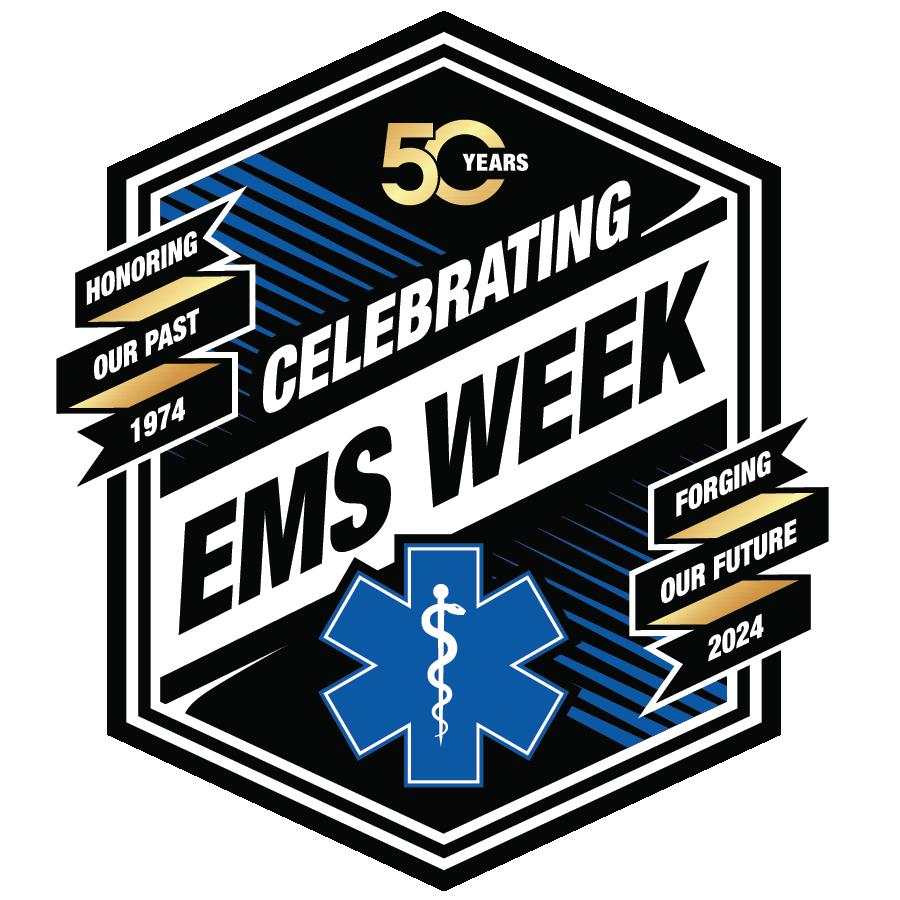

League City Campus now designated as a Level III Primary Stroke Center

For 50 years, the country has dedicated one week a year to honoring team members in the emergency medical services field.
Designated from May 19-25 this year, EMS Week is a time for all of us at UTMB Health to say thanks and pay homage to our partners in the field.
Without them, we couldn’t do what we do every day.
So to all of our EMS colleagues, we thank you. It’s a privilege to serve the community alongside you.
/ EMS
When someone is experiencing stroke symptoms such as facial drooping, arm weakness, speech difficulty, vision problems, confusion or more, instructions are clear, call 9-1-1.
EMS partners in the field are well trained on how to respond to these types of calls, and they rely on organizations like UTMB Health to further assess and care for these patients upon their arrival to the hospital.
Already equipped with a Level I Comprehensive Stroke Center in Galveston and a comprehensive capable center in Clear Lake, UTMB Health now has a Level III Primary Stroke Center at the League City Campus.
“This designation from the Texas Department of State Health Services is a big step forward for the care our stroke program can provide in the area,” said Michelle Vu, service line director for the UTMB Health stroke program. “With this designation, we can now provide ischemic stroke intervention through intravenously administered thrombolytics, and are equipped to handle the neuro-critical care required after the use of that therapeutic.”
Richard Arocho, outreach and marketing liaison with UTMB Health, and Michelle Nyberg, UTMB Health stroke coordinator, have highlighted the new designation—which went into effect in January 2024—when they have visited with EMS partners in the area.
“It is important to ensure EMS personnel are aware of all of our latest capabilities,” said Arocho. “This helps them make informed decisions about where to transport patients to ensure the best possible outcome for the individuals we serve.”
For more information about UTMB Health’s stroke program, visit: www.utmbhealth.com/stroke.
THE DISPATCH AN EMERGENCY SERVICE NEWSLETTER CREATED BY UTMB HEALTH | 07 STROKE
UTMBHEALTH.COM
Responders’ swift actions

For three motorcycle enthusiasts, what started as a beautiful, sunny Easter Saturday riding their bikes along the Gulf Coast in Surfside ended with a trip to the UTMB Health Galveston Emergency Department.
Terri O’Connell and her husband Paul, along with their friend Glenn, were riding their motorcycles together on Saturday, March 30, making leisurely stops along the way. While en route to a new destination, Glenn, who always brings up the rear when this trio rides together, failed to realize Terri was slowing down to make a turn and proceeded to bump and then scrape her bike along its left side before being launched from the moving vehicle.
“I was able to stay upright,” says Terri. “I then witnessed Glenn lay his bike down and tumble and slide down the highway.”
Terri goes on to recount how Glenn’s body eventually came to a stop, but the bike

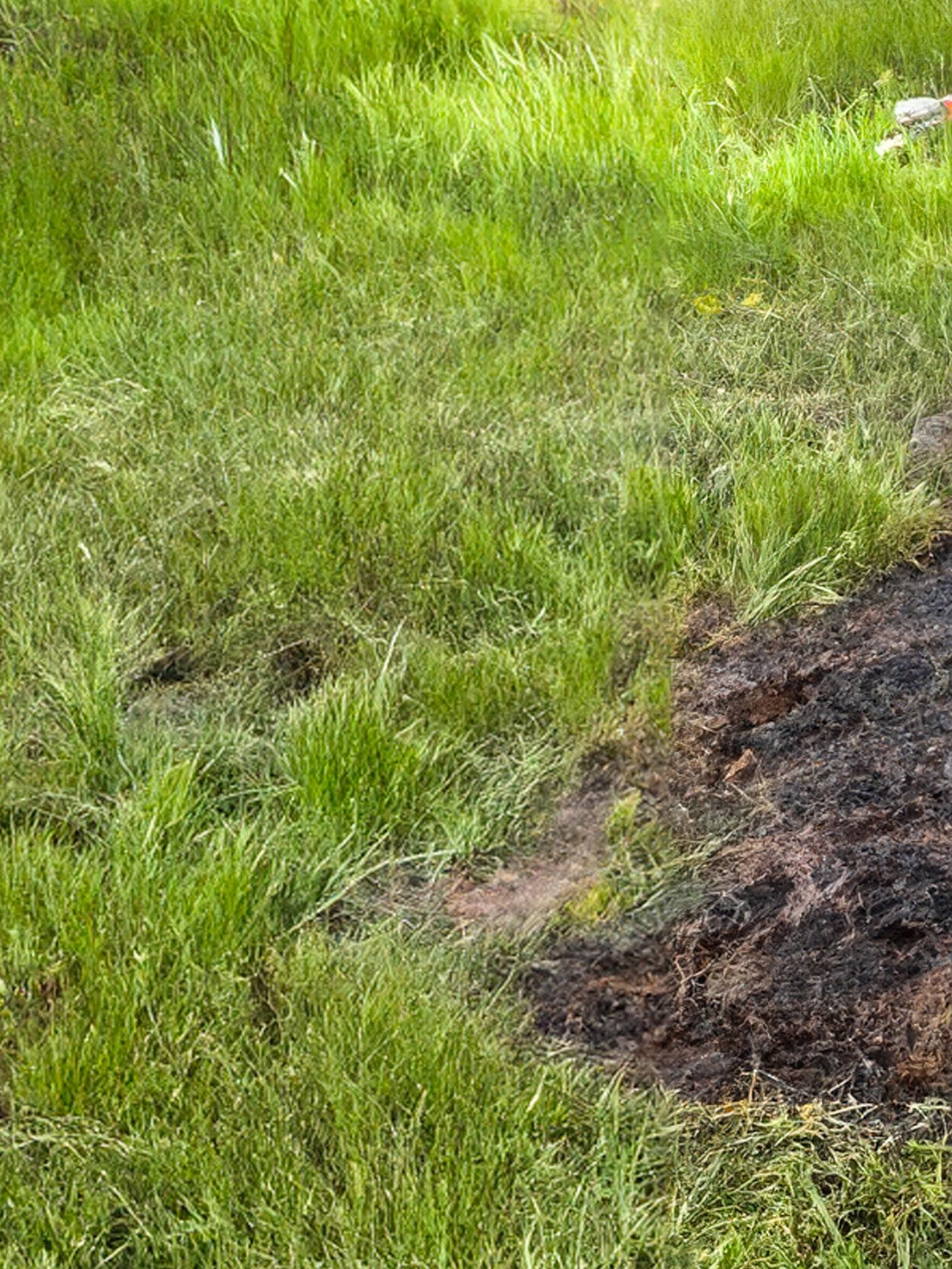
“This incident is a great example of the camaraderie and teamwork that exists throughout the first responder community”
- Christopher Beall, Surfside EMS assistant director
continued for approximately another 50 yards, before combusting in a nearby ditch.
Instantly alarmed and eager to help, Terri ran to check on a now-unconscious Glenn and called 911 as her husband, Paul, who had been well ahead of the commotion, made his way to the scene.
Not being medical professionals, Terri and Paul were hesitant to intervene too much with Glenn
before help arrived, as they didn’t want to make any of his potential injuries worse.
Just as Glenn began to groan and attempt to move, Surfside EMS assistant director Christopher Beall, who just happened to be passing the scene, pulled over and jumped into action, helping as he could.
“He immediately took over as incident commander and began helping our Glenn,” said Terri.
08 | THE DISPATCH AN EMERGENCY SERVICE NEWSLETTER CREATED BY UTMB HEALTH IN THE FIELD
Christopher Beall celebrating his 50th birthday
and teamwork save rider’s life
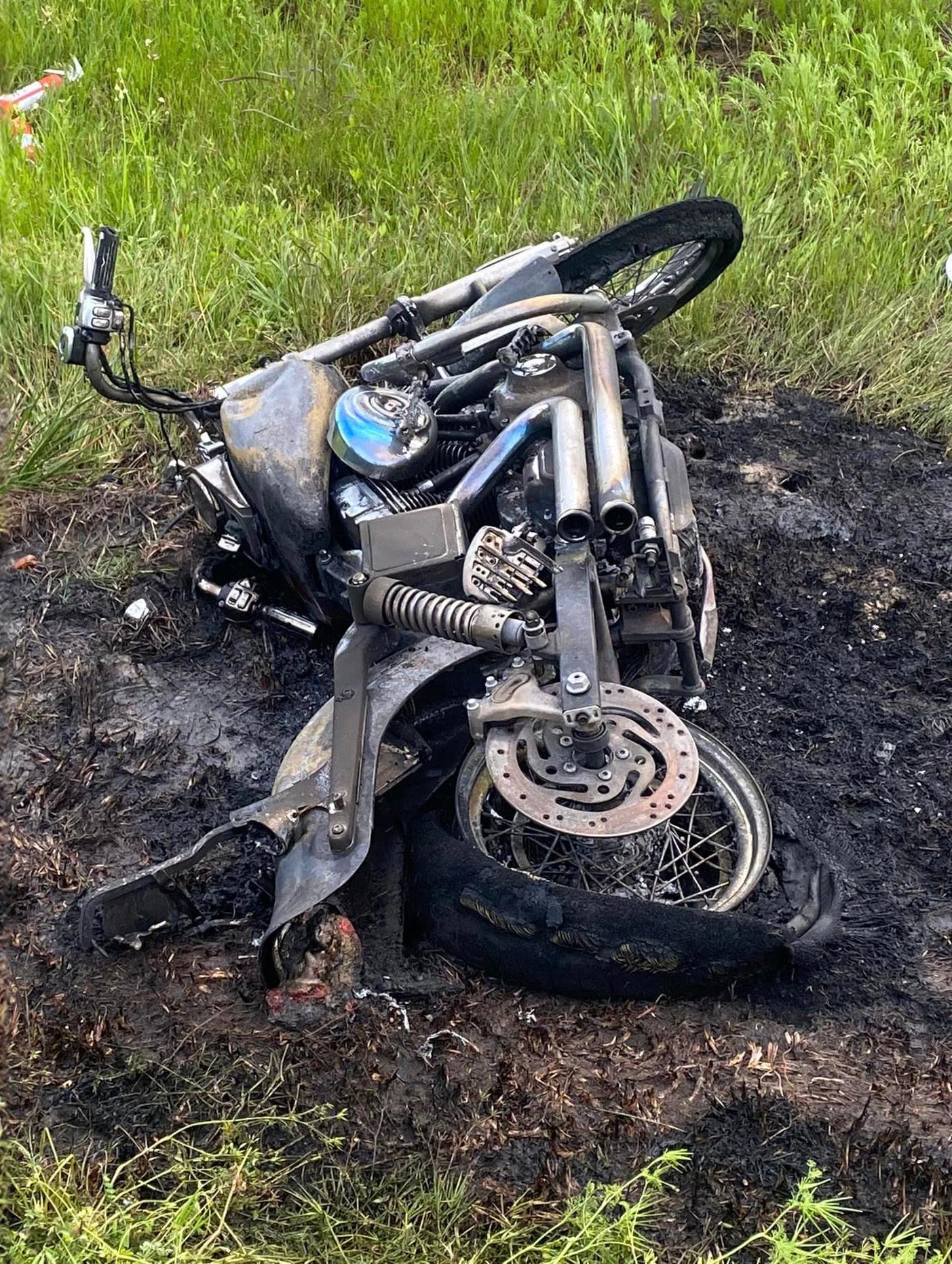
“He was able to get Glenn to speak. It was as if an angel had appeared.”
Formally responding to the call was a crew from the City of Clute’s EMS team.
“The crew from Clute was amazing,” said Beall, who made sure to give the other first responders his assessment of the situation and Glenn’s condition. “They did an amazing job along with the Clute
Volunteer Fire Department and the Brazoria County Sheriff’s Office.”
Due to his head injuries, the first responders decided to call in Life Flight to get Glenn transported to the UTMB Health Galveston Campus for further assessment.
“I magically had no broken bones, and after an overnight stay, I was on my way home the next day,” said Glenn.
A former competitive baseball player, he was once hit in the head with a baseball bat and ended up needing to have a procedure that left him with a titanium plate in his head. That plate is one of the reasons his condition wasn’t worse.
Regardless of what was inside his body that kept him safe, he’s aware of the activity around him that day.
He, Terri and Paul are thankful for the swift, calculated actions taken by all on the scene and at UTMB Health.
“This incident is a great example of the camaraderie and teamwork that exists throughout the first responder community,” said Beall. “Even though we all work for different agencies, we can all still work together, even if we have never met before.”


THE DISPATCH AN EMERGENCY SERVICE NEWSLETTER CREATED BY UTMB HEALTH | 09 IN THE FIELD
Christopher Beall and Emilee Wagley
Strategies and solutions

Emergency Medical Services providers are highly susceptible to sleep disorders
and their inherent dangers and health complications.

They are always facing the challenge of having to work under intense pressure with little or no sleep. When sleep is constantly interrupted, or if a person must fall asleep at an irregular or constantly rotating time, it can seriously impact their physical, emotional and mental health.
Adult and Pediatric Sleep Specialist Dr. Rizwana Sultana said that for people who are working scheduled, rotating shifts several days and nights a week, alignment for their sleep schedule is particularly difficult.
“EMS providers are always on the go; it’s a very high adrenaline job,” she said. “They
come home and must focus on how to relax, because their brain has been so active. My first recommendation is to establish a sleep routine. You can’t have an actual sleep schedule, because shifts will rotate, so build a routine. I have some suggestions.”
“If you look at the clock and think, ‘It’s 2 a.m.! I’m not sleeping!’ You will become anxious, and your brain must not be thinking about anything,” Dr. Sultana said. “No checking the phone. Avoid every kind of stimulation for the brain, and checking time is one of them.”
Because the brain is wired to sleep at night and be awake during the day, the body becomes stressed if it is awake at night.
“It’s very hard to achieve seven to eight hours of restful sleep when your workday is at night, and it’s a day filled with hard
LIFESTYLE 10 | THE DISPATCH AN EMERGENCY SERVICE NEWSLETTER CREATED BY UTMB HEALTH
Dr. Rizwana Sultana
for sleep-deprived shift workers

“Sleep deprivation also causes roadside accidents, which is why it’s important not to drive when you are sleepy”
- Rizwana Sultana, Adult and Pediatric Sleep Specialist at UTMB Health

physical work and mental activity,” she said. “Long-term sleep loss can result in changes in our DNA, increases risk of some cancers, and can cause other health problems. The body requires sleep to recover from the extra wear and tear on the body.”
Sleep deficits also can affect memory over the long term.
“Sleep deprivation also causes roadside accidents, which is why it’s important not to drive when you are sleepy,” she said.
“There are many physical and behavioral consequences to being sleep deprived.” However, helping the brain to transition from active and awake to relaxed and ready to sleep can be achieved by creating and sticking to a routine. While adjusting to a rotating schedule is difficult, optimizing sleep is still possible.

Finding balance: Sleep schedule tips for sleep shifters
1. If you leave work in the daylight, put on dark sunglasses to block out the light
2. Take a relaxing bath or shower when you come home
3. Try stretching and breathing exercises or meditate in a dark room
4. Focus on relaxing each part of your body. Start with, “I’m relaxing my forehead.” Work your way down your body. This helps transition your brain from active to relaxed and ready to sleep
5. Remove interruptions, like the cell phone or other screens or devices
6. Stop drinking caffeinated beverages halfway into your shift
7. Set your alarm, and do not check the time if you wake up. If you do, remain unaware of the time, just breathe deeply, focus on relaxing your body, and go back to sleep
8. If you must sleep during the day when others are awake, play sounds or music that cancel the noise outside
LIFESTYLE THE DISPATCH AN EMERGENCY SERVICE NEWSLETTER CREATED BY UTMB HEALTH | 11
CURIOUS ABOUT THE OUTCOME OF A PATIENT TRANSPORTED TO UTMB HEALTH?
questions and
email Richard Arocho at riarocho@utmb.edu or visit utmbhealth.com/ems

Puzzle located on page 02
Medics can earn continuing education credits at upcoming EMS Lecture Series events on UTMB Health campuses.
• July 19: UTMB Health League City Campus
• Oct. 18: UTMB Health Galveston Campus
The UTMB Health Stroke Program and Trauma Program staff will discuss EMS outcomes, facility capabilities and treatment updates.
Participants can earn 4 CEUs for attending in person and taking part in the skills portion, and 3 CEUs for attending the virtual meeting. To register or to get details, contact Richard Arocho at riarocho@utmb.edu.
CONTINUING EDUCATION Earn credit at EMS Lecture Series events EMS Dispatch Crossword Puzzle 1C R 2C 3M Y 4C L E A R L A K E I S F 5 U R 6T H I R T Y F I V E 7R A J A F E N L T 8S D B Y U A E L A T L 9 E A G U E C I T Y C A M P U S H N A Down: Across: 1. Jeep Weekend location 4. Location for most recent Lecture Series 2. EMS team that responded to Surfside 6. How many years of service Chief Maes has accident with AAEMC 3. first name of nurse and program manager 7. Last name of cardiologist leading EKG with UTMB Health Trauma Services in refresher trainings Galveston 9. designated as Primary Stroke Center 5. how many years celebrating EMS week 8. Last name of UTMB Health Adult and Pediatric Sleep Specialist EMS Dispatch Crossword Puzzle Answers Down: [1] Beach party location [2] EMS team that responded to Surfside accident [3] First name of nurse and program manager with UTMB Health Trauma Services in Galveston [5] How many years celebrating EMS week [8] Last name of UTMB Health Adult and Pediatric Sleep Specialist Across: [4] Location for most recent Lecture Series [6] How many years of service Chief Maes has with AAEMC [7] Last name of cardiologist leading EKG refresher trainings [9] Designated as Primary Stroke Center
For
more,
.























